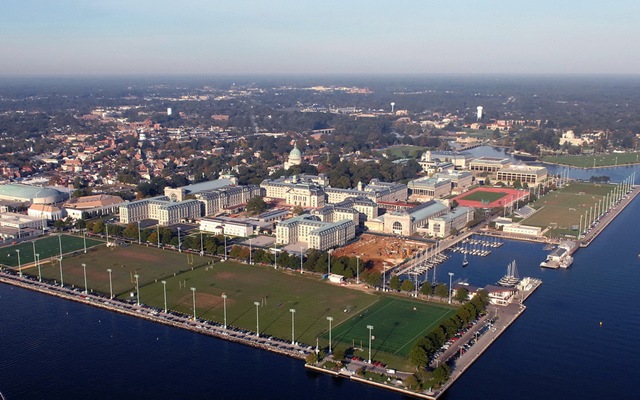
Photo: The United States Naval Academy. Retrieved from: www.pinterest.com
The United States Naval Academy at Annapolis, Maryland trains students for active duty as officers-in-training in the US Marine Corps. Freshmen are called plebes and subsequently, midshipmen. Plebes enter the academy in the summer season for rigorous training. The United States Naval Academy, along with the United States Military Academy and the US Air Force Academy, is consistently ranked as the top public liberal arts college.
The expected work environment in the navy and marine corps as well as the high-tech work involved in navy missions require that all commissioned navy personnel obtain a degree before active duty. The academic program allows graduates to obtain a bachelor of science degree under a curriculum that is designed to evaluate midshipmen’s capability in military leadership and in academics. The academic program is broad and includes active participation in competitive athletics. The Honor Concept is also a big factor in the grading and assessment of students.
Midshipmen that quit the academy during their first two years are not required to serve in military service, but may be required to reimburse the government the sum of their educational expenses, usually in excess of one hundred fifty thousand dollars. Those who are separated – voluntarily or involuntarily – after that time are required to serve on active duty in an enlisted capacity, usually for two to four years. Alternatively, separated former midshipmen can reimburse the government for their educational expenses, though the sum is often in excess of $150,000.
School History
Established in 1845, the USNA was then under Secretary of the Navy, George Bancroft. The US Army post Fort Severn was converted into a campus, which opened in the same year with 50 midshipmen and 7 professors. Then commodore Matthew Perry showed interest in an apprentice program for the US Navy and helped in the creation of the United States Naval Academy curriculum as well as the modernization of naval facilities. The original curriculum involved five years of study, three of which were spent at sea. The school underwent a re-organization in 1850 under the jurisdiction of the chief of the Bureau of Ordnance and Hydrography. The length of the curriculum was expanded to seven years, with the freshman year and the last two years spent in campus and the other years completed at sea. In 1851, practice cruises replaced years of sea training. In 1854, the first students of the academy were awarded degrees.
The year 1860 was historic as this was the year the Tripoli Monument was moved to the campus and the 60-year-old ship USS Constitution was refurbished for use in the training of the fourth-class midshipmen.
After the Civil War, Admiral David Dixon Porter tried to restore the campus starting from 1865. The tradition of class rings was first introduced in 1869. Military budget cuts in the 1870s forced the academy to accept less students and in 1872 only 25 midshipmen graduated. In 1874, the anti-hazing law was established after hazing became ruthless and frequent among the higher and lower class levels. In 1898, the Spanish-American War led to the recognition of the academy’s importance in national security.
A closed-circuit oxygen SCUBA course was introduced for the first time in the United States for the Office of Strategic Services maritime unit in 1943. From 1946 to 1961, midshipmen were taught how to fly using N3N amphibious biplanes.
Competitive athletics was emphasized in the 1900s, and the navy rowing team subsequently won the gold medal at 1920 Summer Olympics Games in Antwerp, Belgium. Three years after, the Department of Physical Training was established in the campus. In 1926, the Navy added the national collegiate football championship title to its list of athletic achievements.
Campus Life
Incoming students should expect rigorous military and academic training in the USNA, and midshipmen are introduced to shipboard way of living as soon as possible. Academic performance is extremely competitive, but most of the students entering the academy are determined to finish the courses and start their active duty right away. While the USNA is co-ed, around 80 percent of the current undergraduate population are males and only around 20 percent are females.
Financial Aid
The U.S. government shoulders the tuition fees, as well as the fees for lodging. Midshipmen receive a pay grade amounting to almost a thousand dollars a month, from which the cost of uniforms, books and other supplies are deducted. The cash stipend that the midshipmen receive at the end of the month varies among classes, with the midshipmen fourth-class receiving the lowest pay of 100 dollars. All midshipmen receive full financial help for obtaining a degree in exchange for the commitment to serve in the Marine Corps, coast guard or other armed services after graduating from the United States Naval Academy.
There are also scholarships offered for high school graduates that meet the requirement, such as the Naval Reserve Officers Training Corps (NROTC) Scholarship Program, which covers up to 100 percent of tuition costs and awards a monthly stipend. The Health Professions Scholarship Program (HPSP) covers the tuition for a medical or graduate health degree program. A recipient of the HPSP scholarship will also receive pay for active duty for a duration of 45 days on an annual basis.
